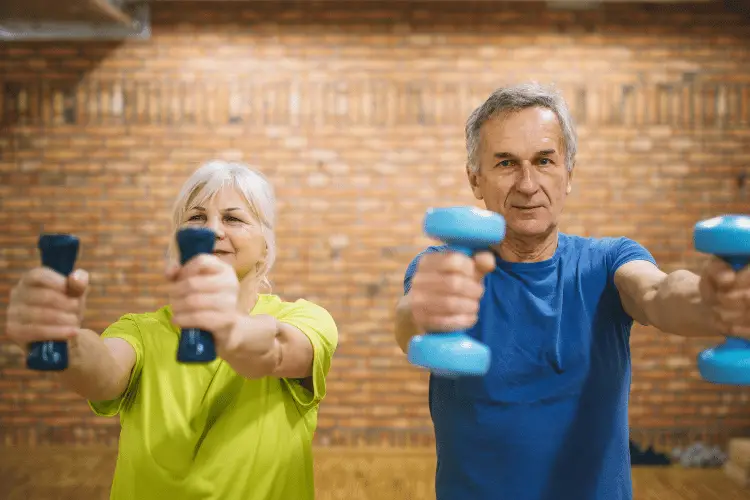The extensive benefits of exercise have been documented by countless researchers and health experts around the world. Aside from the more well-known advantages of improved strength and fitness, it’s proven to have a profoundly positive impact on mental health, sleep, energy, hormones, and your brain.
Exercise extends your lifespan by improving your health, your ability to control your environment, and your overall quality of life. This article covers the statistics on life expectancy and exercise, and sheds light on less-discussed details of exercise, such as how many years it adds to one’s life.
Let’s get into it!
Does Exercise Make You Live Longer?
Countless research has proven that being physically active can make you live longer.
According to a study published by Harvard University, people that partake in the minimum recommended guidelines for physical activity reduced the risk of early death by as much as 21%. Those that exercised two to three times above the minimum physical activity guideline lowered the risk even further at 31%.
Exercise isn’t a “cure-all” for disease, but it can prevent or at least alleviate symptoms of life-long disorders. It can help reduce the risk of chronic—and potentially deadly—conditions, such as Type 2 diabetes, osteoporosis, heart disease, depression, and many types of cancer. It also lowers the risk of developing age-related diseases, like cardiovascular disease and stroke.
A sedentary lifestyle is linked with disease and premature death, as discussed in a study published by the National Library of Medicine. A sedentary lifestyle—i.e., a lifestyle with little to no exercise—is strongly associated with cardiovascular disease, type 2 diabetes, and certain cancers (epithelial ovarian, breast, colorectal, colon, and endometrial cancer).
The risk of developing these diseases is 13% to 20% higher compared to that with non-sedentary lifestyles.
As stated in The Journal of Aging Research, exercise can potentially increase life expectancy by 0.4 to 6.9 years. Control studies on the life expectancy of athletes further validate this fact, revealing that athletes lived an average of five to eight years higher than that of non-athletes.
The message here is simple enough: exercise will, indeed, help you live longer. Even simple lifestyle changes, like walking more, can increase your lifespan by a notable amount. Any kind of exercise is better than no exercise.
How Many Years Does Exercise Add to My Life?
The answer to this question depends on multiple factors, including socioeconomic status, diet and nutrition, genetics, and overall lifestyle. Generally, though, exercise can add anywhere between two to eight extra years to a person’s life.
Life expectancy is directly influenced by the exercise regime you opt into. For example, individuals that partake in the recommended 150 minutes of moderate exercise or 75 minutes of vigorous exercise are shown to live three and a half years longer than sedentary individuals.
Doing twice the recommended amount adds an additional four years, while doing half the amount adds two years.
As detailed in the study led by Harvard professor Dr. I-Min Lee, if you have a normal BMI and exercise in the recommended amount of exercise, you live 7.2 years longer compared to someone who is obese and inactive.
What Kind of Exercise Shortens Your Life?
There’s no single type of exercise that necessarily shortens your life. But, there are various exercise mistakes that can potentially reduce your lifespan if they’re not caught early.
Over Exercising

As the adage goes, too much of anything is bad. Doing up to 10 of the recommended amounts of exercise, which equates to about 12 hours a week, doesn’t have an extra payoff—and may even be harmful to some depending on several factors.
Remember: workouts need to be approached realistically. While it’s tempting for some to exercise for hours on end, the human body can only take so much before it reaches diminishing returns. Challenging yourself is one thing, but pushing yourself beyond your limit is another.
Overexercising is not only counterproductive but can also pose serious health risks that can shorten your lifespan. The rule of thumb here is if the exercise feels too much for your body to handle, it probably is. The intensity, length, and duration of your workout need to be eased in gradually for it to be healthy.
Signs and symptoms of overexercising (overtraining) include:
- Increased injuries
- Decreased immune response
- Extended muscle soreness
- Performance plateaus
- Increased resting heart rate
- Constant lethargy and irritability
- Feelings of depression or anxiety after a workout
Overexercising can lead to various health conditions and overuse injuries, such as muscle strains and sprains, stress fractures, and shin splints. It can also weaken the immune system, which can result in impaired metabolism, hormonal dysfunction, chronic injury, and overall decreased performance.
Exercising in Areas With Air Pollution
Exercising (and just living) in areas with smog—i.e., air pollution—poses the risk of early mortality. If you’re in a heavily polluted city, it is probably best to exercise indoors rather than expose yourself to several times more pollution than your sedentary neighbors. The presence of microscopic particles such as dust, soot, and dirt are linked to an exhaustive list of health complications.
According to the Energy Policy Institute, breathing polluted air can potentially be more dangerous than smoking cigarettes.
Regular exposure to smog increases the risk of heart disease, respiratory infections, and lung cancers, all of which are closely associated with premature mortality. It’s also linked to blindness, as discussed in a study by the British Journal of Ophthalmology.
With the current state of the world, avoiding polluted air is nearly impossible. In the US alone, 4 in 10 people—which equates to 135 million Americans—live with polluted air. Still, there are various ways to protect yourself from unhealthy air.
To start, check the daily air pollution report in the area you’re planning to exercise. If it’s beyond the recommended AQI (Air Quality Index), avoid exercising outdoors. Instead, opt for exercise machines in the gym or shopping mall. Additionally, avoid exercising near high-traffic areas.
Adjust your workouts accordingly so you can minimize the inhalation of smog during your daily exercise.
Improper Nutrition
Exercise and nutrition go hand-in-hand. Lack of proper nutrition during exercise can lower bone density, reduce muscle mass, and cause fatigue. This puts you at risk for illness and injury, hormonal issues, and menstrual issues for women.
Physical activity and healthy nutrition are key lifestyle factors of lifelong health. One won’t work without the other.
Nutritional habits have a significant impact on body composition and fitness. This is why incorporating nutritious foods into your exercise plan is so important.
Carbohydrates provide energy, while protein boosts glycogen storage, promotes muscle repair, and reduces muscle soreness. Fat, particularly unsaturated fat, can reduce cholesterol, resulting in a lowered risk of stroke and heart disease.
Without enough proteins, carbohydrates, and fats, you’ll feel fatigued and sluggish during a workout. As a result, you won’t be able to reach your maximum potential during exercise.
Poor diet is the leading cause of early mortality. If you don’t eat enough before or after exercising, you’ll experience some potentially deadly long-term effects such as nutrient deficiencies, muscle injuries, and heart complications.
Worrying About Not Exercising Enough
Researchers from the American Psychological Association found that individuals who perceive themselves as less active than their peers were up to 70% more likely to die than those who perceive themselves as active.
Living in the belief that you aren’t active is enough to shorten your life. Researchers of the study present a couple of theories as to why this is.
For one, overthinking anything can put you under constant stress, which can increase the brain’s cortisol levels. Increased cortisol not only wears down the brain’s ability to function but also reduces the size of the brain.
Overthinking can also contribute to feelings of depression and anxiety, as well as other mental health disorders.
Another theory is the placebo effect. Just as how the belief of getting pain medicine can activate endogenous opiates in the brain, the underlying dread of not exercising enough—and what that may entail—is enough to actually harm the health.
There’s also the aspect of demotivation. Those that perceive they’re less active than their peers can become discouraged by that perception. This may result in them being less active or stop exercising altogether.
Why Does Exercise Increase Lifespan?
Here are some of the biggest reasons why exercise increases lifespan:
1. Exercise Combats Disease
Exercise helps prevent the development of chronic diseases such as diabetes, arthritis, dementia, depression and anxiety, back pain, and osteoporosis among others.
It can also help strengthen the heart and improve circulation. Exercise increases blood flow, which in turn raises the oxygen levels of the body. This helps lower the risk of heart diseases such as coronary artery disease, high cholesterol, and heart attack.
It also manages triglyceride levels and blood pressure.
2. Exercise Improves Mental Health
Hundreds of studies show that exercise has a profoundly positive impact on mental health.
Exercise releases “feel-good” chemicals called endorphins, which can help ease feelings of depression, anxiety, and stress. Even modest amounts of exercise can trigger this release.
Exercise is often used to treat mild-to-moderate mental health disorders in place of medication because of this reason. Moderate-to-severe mental health disorders use it as a supplement alongside medication and therapy.
There’s also the fact that exercise promotes beneficial changes to the brain. It reduces inflammation, boosts neural growth, and introduces activity patterns that promote feelings of well-being.
It also serves as a good distraction from the stressors of life, giving you a break from the cycle of negative thoughts.
3. Exercise Promotes Better Sleep

Numerous studies have found that lack of sleep is associated with a shortened lifespan. It increases a person’s risk of developing serious medical conditions, such as cardiovascular disease, obesity, diabetes, and others.
This is where exercise comes into play. Regular exercise promotes better sleep by stabilizing the mood and mitigating symptoms of stress, anxiety, and depression.
Additionally, it induces deeper and more restful sleep phases, which alleviate daytime sleepiness and the need for sleep medication.
4. Exercise Helps Control Weight
Up to 2.6 million people die every year from being overweight or obese, making it the fifth leading risk of global death.
Along with a proper diet, exercise can prevent and treat obesity. Physical activity effectively decreases total body fat as well as the fat around the waist, preventing the development of abdominal obesity.
It likewise increases the body’s total energy expenditure, which can help lose weight.
Finally, exercise boosts mood and reduces anxiety and depression. This can motivate people to stick to their exercise over time to prevent and treat obesity.
5. Exercise Reduces the Risk of Fall
The older you get, the higher the risk of tripping or falling while doing everyday activities. This can result in broken bones and other serious injuries.
Exercise reduces this risk by improving your balance, agility, strength, and flexibility. You’re simply less likely to fall, or if you do, it won’t be as severe and you’re able to recover faster. I’ve seen the results of falls in elderly individuals. You could either be active and healthy and end up with a scuffed elbow, or you could end up with a broken hip and several broken ribs.
A study published in the British Journal of Sports Medicine shows that regular physical activity reduces fall rates of older people (65 years or older) by up to 21%. This just goes to show how important exercise is in preventing potentially life-risking fall damage.
The Centers for Disease Control and Prevention reports 36 million falls in older adults each year. Of this, 32,000 result in death. One of every five falls causes an injury, such as a head injury, hip fracture, or broken bones.
Keep on your feet and avoid the risk of falls by adding exercise to your daily routine.
Conclusion
I could go on for days about the many ways you can utilize exercise to extend your life. There are more studies available than I can count.
Like everything, there is a scale to this. If you’re either extreme end of a scale of physical activity (sedentary or maniacally active), you will experience problems. The best thing to do is to find a place right in the middle.
It takes some experimenting to find out how your body best operates.
Most individuals in society lead sedentary lifestyles and are suffering from it.


